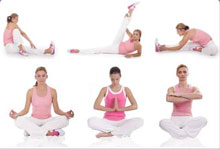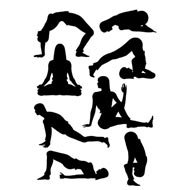Standing Yoga Seal (Dandayamana Yoga Mudrasana)
The standing yoga seal or the dandayamana yoga mudrasana is a form of yoga that tends to utilize two different yoga asanas or poses so as to ensure that the spine is fully stretched and also to promote proper posture.
Standing Yoga Seal Steps :
- To start with the standing yoga seal pose, you should enter into the Mountain pose which involves standing with your feet together and your hands placed at each side with the palms touching your outer thighs.
- Thereafter, after ensuring your balance, you should lift your toes away from the floor and try and spread them as far apart as possible before placing them back onto the floor.
- While tilting the pubic bone forward, you should try to raise your chest forward as this will ensure correct alignment of the spine.
- Thereafter try to lengthen the neck by gently raising your head as much as possible while breathing deeply. Then exhale and raise your arms while pointing your fingers towards the ceiling. This position should be maintained for a few seconds.
- Once done you should again lower your arms to your sides and keep your feet at least three feet apart from each other by spreading your legs.
- Then inhale and bring your arms gently behind your back and bring your shoulder blades as close to each other by interlocking your fingers.
- While doing so, focus on the ceiling and take a few deep breaths for a few seconds.
- Thereafter exhale and keeping your legs relatively straight, by leading with your chest ,hinge the upper body towards the floor.
- Once done, lift your upper body into a standing position and release your hands and bring the arms back to the sides of your body.
Standing Yoga Seal - Precautions :
Individuals who are suffering from any chronic or even a recent injury to their neck , shoulders or back or even those who are diagnosed with high blood pressure should refrain from practicing this yoga pose without prior consent of the doctor.
Benefit of Standing Yoga Seal Pose To The Body Parts and Therapeutic Applications include:
- Improvement on the overall mental functioning of the individual
- This pose of yoga is also known to be effective in harmonizing the connection between the mind and the heart.
- The standing yoga seal pose is also beneficial in stretching and opening the upper back, shoulders and legs.
Beginner’s Tip :
Those starting with the standing yoga seal pose should bear in mind that a tight chest and hamstrings tend to restrict movement and hence you should do some amount of light stretching or warm-ups before getting into this pose.
Variations :
- One of the variations that can be used for the standing yoga seal pose is to try and step with your feet apart so as to make it easier to hold the pose and alternatively keep the feet closer together to make this pose even more challenging.
- Alternatively you may also use a yoga strap that should be held between your hands while practicing this pose.
- Similarly as you grow more used to this pose and are more comfortable in practicing the standing yoga seal pose, you may try to straighten your legs and arms even more so as to maximize the stretch. Another variation of the standing yoga seal pose is to interlock your fingers behind your back after your last inhale and this time ensure that your palms are facing one another for maximum benefits.
 Find Pose
Find Pose

